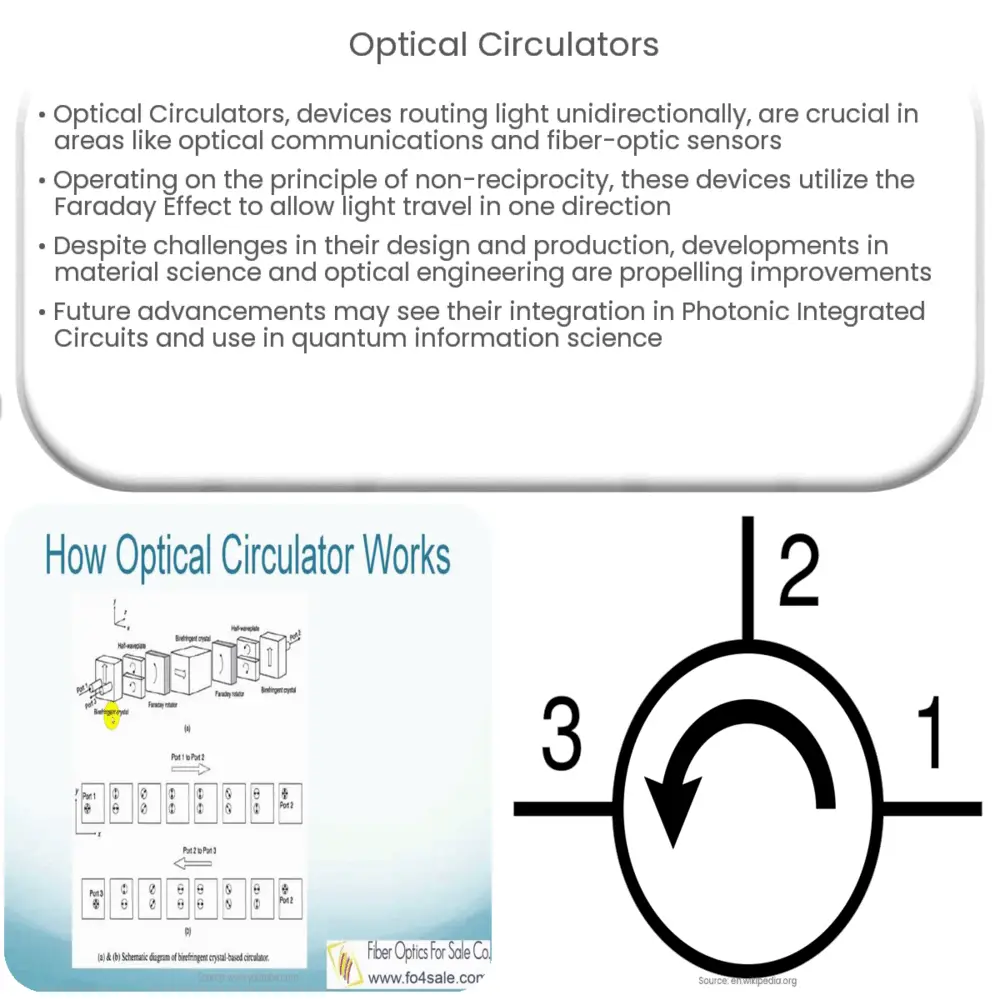Explore the fundamentals of Optical Circulators, their design, applications, challenges, and future prospects in optical technology.

Introduction to Optical Circulators
An Optical Circulator is a non-reciprocal device that routes light from one port to the next, in a unidirectional manner. This unique device has broad applications in many fields, from optical telecommunications to fiber-optic sensor systems.
Working Principle of Optical Circulators
Optical Circulators are based on the principle of non-reciprocity. They operate by shifting the phase of light, creating a condition where light can travel in only one direction. This is typically achieved using the Faraday Effect, a magneto-optical phenomenon that causes the polarization plane of light to rotate under the influence of a magnetic field.
Structure and Design
Optical Circulators generally have a three-port structure. However, four-port and more complex designs exist as well. The structure includes an input port (Port 1), an output port (Port 2), and a port for unused signals (Port 3). Light entering from Port 1 exits from Port 2, light entering from Port 2 exits from Port 3, and so on. Crucially, light cannot travel in the reverse direction.
Applications of Optical Circulators
The unique properties of Optical Circulators make them indispensable in numerous areas. Some key applications include:
- Optical Communications: Optical Circulators are widely used in Dense Wavelength Division Multiplexing (DWDM) systems, which involve the simultaneous transmission of multiple wavelengths of light along the same fiber.
- Fiber-optic Sensors: These sensors often use Optical Circulators to separate the incoming and outgoing signals, enhancing their performance and sensitivity.
- Optical Amplifiers: In Erbium-Doped Fiber Amplifiers (EDFAs), Optical Circulators can help direct pump light and signal light effectively.
Despite their widespread use, the design and manufacture of Optical Circulators present significant challenges. These involve factors like device size, isolation between ports, insertion loss, and operational wavelength range. Nevertheless, advancements in material science and optical engineering continue to drive improvements in Optical Circulator technology.
Future Prospects
The future of Optical Circulators appears bright, with emerging technologies potentially opening up even more applications. In the next section, we will explore some of these advancements and their implications.
Emerging Technologies and Advancements
In recent years, numerous research efforts have focused on optimizing Optical Circulators and exploring their use in novel applications. For instance, the integration of Optical Circulators into Photonic Integrated Circuits (PICs) could significantly enhance the functionality and performance of these chips. Similarly, Optical Circulators may play a critical role in the burgeoning field of quantum information science, facilitating more efficient information transfer in quantum communication networks.
Challenges and Solutions
However, these advancements come with their own set of challenges. The integration of Optical Circulators into PICs requires overcoming technical hurdles related to device size and compatibility with existing fabrication processes. In the quantum realm, ensuring that Optical Circulators can operate at single-photon levels is a significant challenge.
Despite these hurdles, solutions are being sought. Researchers are exploring the use of new materials and innovative design strategies to miniaturize Optical Circulators and make them compatible with PIC fabrication processes. Additionally, efforts to develop quantum-compatible Optical Circulators are underway, spurred by advances in low-loss materials and quantum optics.
Concluding Thoughts
In conclusion, Optical Circulators are a cornerstone of modern optical communication systems, with a wide range of applications extending into fiber-optic sensors and optical amplifiers. Despite the challenges in their design and manufacture, ongoing advancements in material science and optical engineering promise to drive the future growth of this field. The integration of Optical Circulators into Photonic Integrated Circuits and their use in quantum information science represent exciting frontiers for this technology. As we continue to push the boundaries of what is possible with light, the importance of Optical Circulators is likely to grow, illuminating the path towards the next generation of optical technologies.

